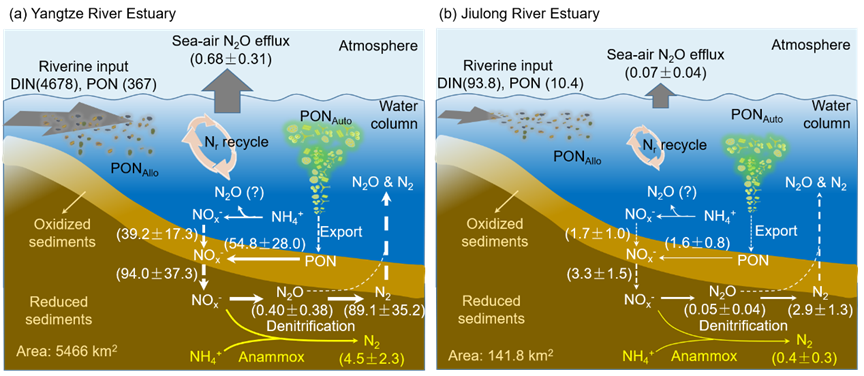工业革命以来,人为活动引起的活性氮添加已经成为仅次于生物多样性危机的第二严重的全球生态环境问题,而近岸水域生态系统受到的干扰尤为严重。微生物介导的反硝化和厌氧氨氧化是自然生态系统中两个主要活性氮的移除通路,是地球系统的自净过程。有趣的是反硝化以强温室气体氧化亚氮(N2O)为中间产物,而厌氧氨氧化则是环境友好过程。因此,两者的量级及其相对重要性决定了局部或全球尺度上地球系统的氮汇大小及气候反馈作用。河口作为重要的陆海界面,接受了大量陆源活性氮,是氮移除发生的热点场所。然而,在全球活性氮持续增加背景下,河口环境中沉积物氮移除过程机制、环境调控及其环境和气候效应仍未得到充分认识。定量化解析河口沉积物氮移除过程的环境与气候效应对参数化生物地球化学模型,控制与缓和近岸环境氮污染具有重要科学意义。
Since the industrial revolution, anthropogenic reactive nitrogen (Nr) addition has become the second most serious global ecological problem after the loss of biodiversity, particularly in nearshore waters. Microbially-mediated denitrification and anaerobic ammonium oxidation (anammox) are the two major Nr removal pathways in natural ecosystems and serve as self-purification processes for the earth system. Interestingly, denitrification produces nitrous oxide (N2O) as a byproduct, while anammox is a more climate-friendly process involving no N2O emission. Thus, the magnitude and proportion of these two processes largely determine the size of the nitrogen sink and N2O source at regional and global scales. Located at the land and ocean interface, estuaries receive a large amount of reactive nitrogen from basins and deliver it into the coastal seas, acting as hotspots for Nr removal. In the context of the continuous increase of global Nr, however, the mechanisms of sediment nitrogen removal processes, environmental regulation and their environmental and climatic effects in estuarine environments are still not fully understood . Quantifying the environmental and climatic effects of sediment nitrogen removal processes in estuaries is of great scientific significance for parameterizing biogeochemical models, and will be helpful for the control and mitigation of nitrogen pollution in coastal environments.
近日,南海海洋资源利用国家重点实验室高树基团队发表题为“Quantitatively deciphering the roles of sediment nitrogen removal in environmental and climatic feedbacks in two subtropical estuaries”的研究成果。该研究基于稳定氮同位素示踪技术,探究了长江口和九龙江河口沉积物氮移除机制,定量化解析了亚热带河口沉积物反硝化和厌氧氨氧化过程在活性氮脱除和气候反馈方面扮演的角色。研究结果表明:(1)反硝化主导河口沉积物脱氮,厌氧氨氧化仅占8.6%,同时反硝化过程导致了1.8%脱除的氮以N2O形式释放;(2)有机质降解驱动了沉积物氮移除并衔接了水体和沉积物的氮迁移转化过程;(3)长江口和九龙江河口沉积物脱氮通量仅占河流输入活性氮通量的1.9%和3.2%(图1),意味着尽管河口沉积物具有较大的单位面积氮移除通量,但受限于面积,在活性氮移除方面扮演较弱角色。绝大部分活性氮将通过河口递送到陆架海,并进一步通过浮游植物吸收-有机颗粒沉降-降解-耦合硝化反硝化等一系列过程实现脱氮;(4)长江口和九龙江河口沉积物氮移除过程伴随的N2O释放分别占日海气N2O通量的59%和65%(图1),展示了其重要的气候反馈作用。
Recently, Shuh-Ji Kao ’s group in MRU published a paper entitled “Quantitatively deciphering the roles of sediment nitrogen removal in environmental and climatic feedbacks in two subtropical estuaries”. Based on stable nitrogen isotope tracing technology, this study investigated the nitrogen removal mechanisms in sediments of the Yangtze River Estuary and Jiulong River Estuary and quantitatively deciphered the roles of denitrification and anammox in environmental and climatic feedbacks in subtropical estuaries. The results showed that: (1) denitrification predominated the sedimentary nitrogen loss in the estuary, and anaerobic ammonia oxidation accounted for only 8.6%, while denitrification led to the release of 1.8% of the removed nitrogen as N2O; (2) organic matter degradation drives the sediment nitrogen removal and bridged the nitrogen transformation processes between the waters and sediment; (3) Nr removal fluxes in the Yangtze River Estuary and Jiulong River Estuary only accounted for 1.9% and 3.2% of the riverine input Nr fluxes, respectively (Fig. 1), implying that although estuarine sediments had a large areal nitrogen removal flux, they were limited by their size and played a weak role in riverine inputted Nr removal. Most of the Nr would be delivered to the shelf sea through the estuary, and further removed via phytoplankton assimilation-sedimentation-degradation-coupled nitrification-denitrification; (4) Denitrification-induced N2O release flux accounted for 59% and 65% of the daily sea-air N2O emission in the Yangtze River Estuary and Jiulong River Estuary respectively (Fig. 1), demonstrating its important climate feedback role.
Image

图1 定量化解析(a)长江口和(b)九龙江口沉积物氮移除过程及其气候反馈
Fig. 1 The conceptual diagram to illustrate the roles of sedimentary nitrogen removal in environmental and climatic feedbacks in (a) Yangtze River Estuary and (b) Jiulong River Estuary
(https://www.sciencedirect.com/science/article/abs/pii/S0043135422010673?via%3Dihub)
在未来人为活动和全球变化持续强化的背景下,河流输送的无机、有机活性氮将会进一步增加,将可能刺激沉积物氮移除及其介导的N2O释放。在此情景下,陆架海沉积物氮移除在环境和气候反馈方面的重要性必须得到进一步的重视。
As anthropogenic interference and global change intensify persistently, the riverine inputted inorganic nutrients, allochthonous and autochthonous particulate organic matter are projected to increase. The increase of particulate organic matter deposition onto sediments may stimulate sedimentary nitrogen removal and associated N2O production. In general, the results highlight the importance of sediment N removal on the coastal shelf in the aspect of ecosystem climate response.
该研究论文于2022年9月13日发表于环境科学与生态学研究领域国际顶级期刊《Water Research》,海南大学为第一单位。该论文由多个单位合作完成,其中海南大学南海海洋资源利用国家重点实验室谭萼辉副研究员为第一作者和通讯作者,高树基教授为共同通讯作者,此外台湾中央研究院许庭彰博士、汕头大学颜秀利博士、海南大学郑珍珍、郑立伟和徐敏副研究员为合作作者。
The research paper, with Hainan University as the first unit, was published on September 13, 2022 in Water Research, a top international journal in the field of environmental science and ecological research. The paper was co-authored by several units. Associate Research Professor Ehui Tan of MRU was the first and corresponding author, Professor Shuh-Ji Kao was the co-corresponding author, Dr. Tingzhang Xu of Academia Sinica, Dr. Xiuli Yan of Shantou University, and Associate Research Professor Zhenzhen Zheng, Liwei Zheng and Min Xu of Hainan University were co-authors.
该研究获得了国家自然科学基金(#91851209、#42276043、#41721005和mechanism of elemental cycling by microorganism in the hydrosphere "Integrated project on the mechanism of carbon, nitrogen and sulfur cycling by microorganisms and carbon source and sink effects in the sea–land transition zone)和厦门大学近海海洋环境科学国家重点实验室访问学者基金(MELRS2114)的共同支持。
The study was supported by the National Natural Science Foundation of China (#91851209, #42276043 and #41721005) and the National Natural Science Foundation of China project (mechanism of elemental cycling by microorganism in the hydrosphere "Integrated project on the mechanism of carbon, nitrogen and sulfur cycling by microorganisms and carbon source and sink effects in the sea–land transition zone". This study was supported by the MEL Visiting Fellowship (MELRS2114).
原文链接:
https://doi.org/10.1016/j.watres.2022.119121
初审:高树基
撰稿人:谭萼辉
翻译:张宇
终审:邓群
First reviewer: Shuh-Ji Kao
Chinese writer: Ehui Tan
English writer: Yu Zhang
Compositor: Xinlin Dai
Final reviewer: Qun Deng
 公众号
公众号